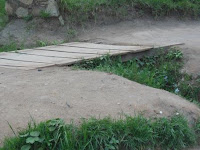 Sunday, July 19th through Sunday, July 26th the 8th National Youth
Bible Camp of EELC (Église Évangélique Lutherienne du Cameroun – the
Evangelical Lutheran Church of Cameroon) took place in Garoua Boulai. Between 250 and 300 Lutheran youth from all
around Cameroon attended. I
Sunday, July 19th through Sunday, July 26th the 8th National Youth
Bible Camp of EELC (Église Évangélique Lutherienne du Cameroun – the
Evangelical Lutheran Church of Cameroon) took place in Garoua Boulai. Between 250 and 300 Lutheran youth from all
around Cameroon attended. I
Where would
you lodge all these young people??
Remember GB doesn’t have hotels and motels like most towns this size in
the US. There is one hotel and various
guest houses, but they are more expensive than the church would want to
spend. Church members hosted some; some
stayed in the Bible School students’ houses (since they are in their villages
for the summer) and some stayed in the Bible School itself with church members
lending the mattresses for the last two places.
 The theme
for the camp was “The youth of EELC and the preservation of peace in Cameroon according to 2 Timothy 2:22-26.” Youth
attended conference sessions, worshiped together and went into the community to
listen to members or those with difficulties.
(They prepared a list so that the catechists and pastors can follow up
with these people in the future.)
The theme
for the camp was “The youth of EELC and the preservation of peace in Cameroon according to 2 Timothy 2:22-26.” Youth
attended conference sessions, worshiped together and went into the community to
listen to members or those with difficulties.
(They prepared a list so that the catechists and pastors can follow up
with these people in the future.)
Two
evenings they met on the lawn outside the Bible School for music and some
speeches. Thursday evening it went on
until about 10 p.m. The sound system was
a good one – they could have been in the living room with me! (And, there
weren’t a lot of distortions even with it that loud). Saturday night they wanted to sing, dance and
pray all night, but (fortunately for me) it rained. They started, took a break for some heavy
rain, started again, and had to quit again when more heavy rain fell. They had a bonfire that night, too. Too bad (for them). I wouldn’t have been happy had they gone all
night, but having more time together would have been good for them!
Imagine
preparing food for so many people for a week!
Yes, caterers do it in the USA, too – and 300 is a lot less than the
30,000+ that went to Detroit! But, here
the women prepared all the food over wood fires outside. That’s a challenge at any time, but
especially in the heart of the rainy season.
I found out that the Mayor of GB donated a cow (to be butchered and
cooked!) I know that in the US I don’t think about where the meat for so many
people comes from. Here, you buy the
whole animal – or several of them for lots of people and lots of meals!
 The camp
ended with the worship service Sunday.
Most of the youth attended the French service at the Central Lutheran
Church (where I usually attend). A few
who live the furthest away – Douala and Yaoundé, for example, left early Sunday,
but most participated. What a joyful
service. Lots of singing and
celebrating. At one point all of the
youth who participated went upfront to sing a song. Most of them were wearing
the t-shirts they had been given – sort of sounds like Detroit, no?! This picture captures most of the youth, but
the ones on the edges were cut off! It
was a lot of kids.
The camp
ended with the worship service Sunday.
Most of the youth attended the French service at the Central Lutheran
Church (where I usually attend). A few
who live the furthest away – Douala and Yaoundé, for example, left early Sunday,
but most participated. What a joyful
service. Lots of singing and
celebrating. At one point all of the
youth who participated went upfront to sing a song. Most of them were wearing
the t-shirts they had been given – sort of sounds like Detroit, no?! This picture captures most of the youth, but
the ones on the edges were cut off! It
was a lot of kids. Interesting
note: The sanctuary has large windows in
the front; parts of these are open air so it is not unusual to see small birds
flying around near the front. As I tried
to take a picture of them Sunday, I ended up getting the beginnings of a wasps
nest – and later part of the bird’s nest in the rafters! All God’s creatures
got a place in the choir! (or at least in the church.)
Interesting
note: The sanctuary has large windows in
the front; parts of these are open air so it is not unusual to see small birds
flying around near the front. As I tried
to take a picture of them Sunday, I ended up getting the beginnings of a wasps
nest – and later part of the bird’s nest in the rafters! All God’s creatures
got a place in the choir! (or at least in the church.)
It was fun
watching from the sidelines. Here’s a picture of a bus some youth rented. I hope that everyone who attended was able to
travel safely home with great memories and inspiration as they work for peace
in Cameroon.































